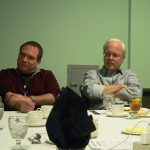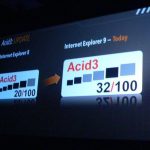New EU antitrust commissioner will oversee Microsoft, Oracle+Sun, Intel issues

The final word over whether the European Commission has accepted, and is willing to oversee the deployment of, a new "ballot screen" that gives Microsoft Windows users the choice of Internet Explorer or a competitive browser, may not be given by Neelie Kroes after all. Despite her prominent role as the European Commissioner for Competition, often siding against the United States with respect to Microsoft and other issues, Comm. Kroes will be swapping roles with her fellow Commissioners next month, as her term in the antitrust oversight role expires in January.
To replace Kroes, EC President José Manuel Barroso has chosen Joachín Almunia, currently the continent's Commissioner for Economic and Monetary Affairs -- essentially its finance minister. Almunia is well-known throughout Europe, and especially in his native Spain, where he distinguished himself as the Socialist party candidate for Prime Minister in 2000. He's perceived as a trusted associate of Barroso, although his executive authority will be ceded somewhat to a new executive branch of government, by virtue of the recent ratification of the new Lisbon Treaty.
Apple invokes DMCA, claims Psystar is 'trafficking in circumvention devices'

One of the reasons Apple Inc. has been the most venerable opponent a courtroom defendant may face, is because of a significant trump card the US Supreme Court handed it in 1983. In a landmark case that rendered "Apple II clones" effectively illegal, the high court established a unique precedent for determining liability and damages in software copyright cases. It assumed that since any legitimate US company is capable of performing legitimate business, the possible damage a defendant might suffer from an injunction against possibly infringing software is outweighed by the simple declaration that such business is illegitimate.
So it was that, with amplification supplied by a citation of the Digital Millennium Copyright Act, Apple invoked its own case law -- citing Apple v. Franklin -- in arguments in recently revealed court papers that Psystar should be permanently enjoined from selling "Mac OS X clones." The specific passage is this: "Where the only hardship that the defendant will suffer is lost profits from an activity which has been shown likely to be infringing, such an argument in defense merits little equitable consideration."
Microsoft 'worked with Apple' for Silverlight on iPhone, says Goldfarb

It was an impressive demonstration, once they got it working: H.264 video streaming wirelessly (and slowly, at least during the caching sequence) using Microsoft's Silverlight video streaming, to an Apple iPhone. It's all the more impressive when you realize that Flash video still has not made its way (permanently) to the iPhone, not for any technical reasons we know of...simply because Apple wants to control the video channel for streaming media to its devices.
And yet here it is, a Microsoft stream. You'd think Apple would have stood firm against Microsoft at least as aggressively as it has against Adobe, if not more so. How did this happen? We asked Microsoft User Experience Platform Manager Brian Goldfarb last week at PDC 2009, and the answer was a huge surprise...followed by some caveats. But it contained these four amazing words: "We worked with Apple."
Microsoft's Ray Ozzie: 'Nobody's going to be 100% open'

Over the last five years, Microsoft has undergone a gradual, but significant, shift in its public image, a shift toward interoperability and a willingness to play more fairly in competitive markets. At the same time, it remains a commercial software producer committed to the protection of its proprietary intellectual property.
Openness, as CEO Steve Ballmer explained to his company's Worldwide Partner Conference in July 2008, should not imply free. "Open source also implies free -- free is inconsistent with paying for lunches at the partner conference," he told attendees at the time.
A case study in improving software: What Office 2010 can learn from Notion 3

On the surface, this is a review of a music composition product entitled Notion 3, from Notion Software, priced at $249 suggested retail, born out of the original VirtuosoWorks product produced in 2005 by music professor Dr. Jack Jarrett, and which produces realistic orchestral sound from precisely notated sheet music on a standard Windows-based PC or Mac. But if you've never composed music before, and even if you don't plan on doing so in the future, I urge you to read on anyway, because this is about the business that we are all engaged in.
Will Firefox beat IE9 to Direct2D rendering?

It was a principal element of the Day 2 keynote at Microsoft's PDC 2009 conference last week in Los Angeles: an early demonstration of code being worked into Internet Explorer 9 that replaces the browser's outdated reliance upon the (very) old GDI rendering library, with new code utilizing Direct2D -- a library that borrows processing power from the GPU. But with the project only having begun last October, it could still be several months before Microsoft creates still more features to make IE9 worthy of a point-release.
By that time, Mozilla could very well have absorbed Direct2D capability into Firefox, if it accepts the contribution of engineer Bas Schouten. By modifying a recent daily build of the organization's "Minefield" track for Firefox 3.7 Alpha 1 for Windows, Shouten was able to graft Direct2D support onto the browser, which also usually relies on the old GDI library. The results were Web pages that were as instantaneous to the eyes as the demos we saw of Direct2D rendering on IE9 test code last week.
Microsoft's Bob Muglia and Ray Ozzie on Silverlight vs. standards

Last week at Microsoft's Professional Developers' Conference, Betanews had the honor of being invited to join a small cadre of reporters -- including noted blogger Long Zheng; TechCrunch's Steve Gillmor; and our good friend from SD Times and Technologizer, David Worthington -- for a luncheon with Microsoft's President of Server and Tools, Bob Muglia; and Chief Software Architect Ray Ozzie. There, we discussed a handful of topics -- some of their comments were candid and off the record, and some were for the record.
The first issue on our plate Tuesday afternoon concerned Silverlight, and Microsoft's continuing efforts to entice developers to build Web sites around a platform that is not considered a "standard," and perhaps never will be. Some developers discount Adobe Flash as a "standard" for the same reason; while others suggest that Flash's ubiquity renders it a de facto standard.
The questions for Web developers have centered around whether they can afford to evolve any portion of their forward-facing online assets around a proprietary standard (around Silverlight) and still have it be on "the Web," whose values are based around platform neutrality. Those questions do seem a bit more pronounced for Microsoft than for other platform developers. But how should Microsoft handle the delicate issue of developing for a platform that's "ours" versus one that is "yours?" (And what's the difference really?)
Google's value proposition for Chrome OS: Should we feel insulted?

Let's be absolutely honest and straightforward about this right up front: Google Chrome OS is not an operating system. It's a device, like the iPhone, only that Google wants to license its specifications to OEMs. Any OEM that builds it is making a Chrome device, whose profile will be so low that it could probably never be switched out to run Windows, even XP. Probably great connectivity, but not enough solid-state storage to manage local documents or store many media files.
More than an Android device, less than a Windows device.
PDC 2009: What have we learned this week?

It ended up being a somewhat different PDC conference than we had anticipated, and even to a certain extent, than we were led to believe. Maybe this was due in part to a little intentional misdirection to help generate surprise, but in the end, the big stories here in Los Angeles this week were more evolutionary than revolutionary. That was actually quite all right with attendees I spoke with this week, most of whom are just fine with one less thing to turn their worlds upside down. It's tough enough for many of these good people to hold onto their jobs every week.
We'll start our conference wrap-up with a look at the flashpoints (remind me to call Score Productions for a jingle to go with that) we talked about at the beginning of the week, and we'll follow up with the topic that crept in under the radar when we weren't expecting.
PDC 2009: Microsoft cares about Web browser performance

I know when I've hurt a man's feelings. In a segment of the technology business that has recently become fiercely competitive, it's difficult to report bad news about a team that tries very hard to build a good Web browser. It was very apparent from our interview today at PDC 2009 in Los Angeles that Microsoft Internet Explorer General Manager Dean Hachamovitch has an emotional and personal investment in the product he's building.
"If I had a script engine that was twice as fast as the one before, the Web should be twice as fast," said Hatchamovitch today. "But if JavaScript is 10 percent of my site, at most, I'll shave 5 percent off; and if the site was 1.8 seconds, yea, I'm not going to be able to tell...Yes, we understand that there's a microscope on JavaScript performance. We've made progress on JavaScript performance -- we're all in the same neighborhood now."
PDC 2009 Post-keynote Day 2: What are we learning today?

The Day 2 keynote is actually still ongoing at the time I'm writing this -- it's run 20 minutes over schedule, and the SharePoint demos are still going on. But here's an assessment of the information we've received thus far today:
First of all, the first news on Internet Explorer 9. If you weren't listening closely to Windows Division president Steven Sinofsky, you might have missed this little fact: The team is only three weeks into the project, having just started after the Windows 7 launch. Now, think about that for a bit: The implication here is that the development team cannot work on the operating system and the Web browser at the same time. This from the company that used to argue that the two components were inseparable.
Then there is the whole "three weeks in" news...It's difficult to believe that Microsoft hasn't really been working on a Web browser since last March, and I actually expect Dean Hachamovitch, who leads IE8 design, to contradict that bit of information. He and his team haven't been lying dormant.
PDC 2009: Live from the Day 2 keynote

Microsoft's Windows division president Steven Sinofsky is the headliner for today's Day 2 keynote at PDC 2009, and Betanews has its usual front-row seat.
11:04am PT: Promise of discussion on Windows Mobile at MIX '10 next March 15-17 in Las Vegas -- notice once again that the number "7" is omitted from the reference to this product. Keynote ends 35 minutes over schedule.
PDC 2009: Windows Server's plan to move customers back off the cloud

Much of the value proposition for Windows Azure -- the star of the show Tuesday at PDC 2009 in Los Angeles -- has been its ability to open up new business avenues for customers who had not been able to envision hosting high-intensity data center operations before. Azure could give these customers a leg up, a new and more affordable way to get off the ground.
But once they're off the ground, the question becomes, why stay up in the air? What's to keep those customers grounded -- to mix metaphors like an old editor of mine -- in the cloud? The surprise answer to that question is coming from a senior product manager for Windows Server, not Azure. Scott Ottaway told Betanews today that provisions are being planned for customers to move their deployed applications back off the Azure cloud, onto on-premises data center servers.
PDC 2009 Day 1, post-keynote: What are we learning so far?

What we're seeing evidence of today is a kind of Microsoft restructuring in progress -- a slow shift toward a future revenue model that actually began about two years ago. Rather than alert Dow Jones as to the need for major structural change, the company did what its MVPs have always suggested enterprises do for themselves: Don't panic, plan, and take things slowly.
But this means juggling a lot of balls in the air in mid-transition, the move to a more global network-centric and license-based revenue model. So individuals who were looking for the launch of a boxed product today, something with a jazz theme and a celebrity to accompany it, were probably disappointed -- but that's no evidence of the lack of a strategy. We're seeing a framework shift, and if you look at Microsoft using the old frame, you don't see the whole picture.
Live from the PDC 2009 Day 1 keynote

Chief Architect Ray Ozzie is scheduled to be the main presenter this morning at PDC 2009 in Los Angeles. We're in our usual location at the press box.
10:05am PT: New applications server called App Fabric goes into beta today, Muglia announced -- a "platform for building scale-out, high-tier services." Enabling developers to concentrate on core functionality, fielding out the failover part of the operation to Microsoft. Database cache is kept entirely in the cloud. Sounds at first glance like a more pre-packaged, buffet-table-based model for delivering cloud-based applications through Azure.
BetaNews, your source for breaking tech news, reviews, and in-depth reporting since 1998.
© 1998-2025 BetaNews, Inc. All Rights Reserved. About Us - Privacy Policy - Cookie Policy - Sitemap.
